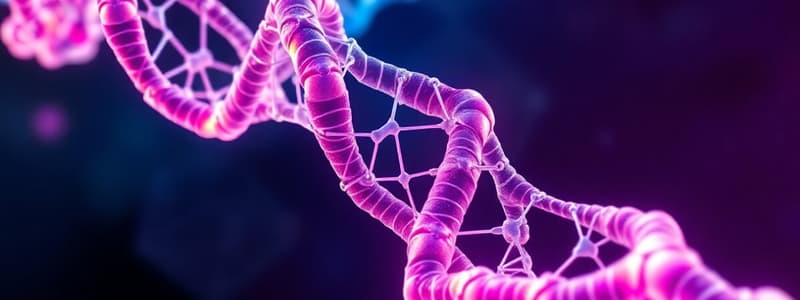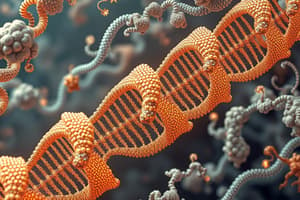Podcast
Questions and Answers
What two dihedral angles are essential for describing the backbone conformation of a protein?
What two dihedral angles are essential for describing the backbone conformation of a protein?
- Omega and Delta
- Gamma and Sigma
- Alpha and Beta
- Phi and Psi (correct)
Which of the following areas on a Ramachandran plot indicates minimal strain and van der Waals clashing?
Which of the following areas on a Ramachandran plot indicates minimal strain and van der Waals clashing?
- Red areas
- Green areas (correct)
- Blue areas
- Yellow areas
What is the relationship between positive phi values and backbone conformations?
What is the relationship between positive phi values and backbone conformations?
- They promote H-bonding interactions.
- They are largely disallowed. (correct)
- They enhance amino acid stability.
- They are commonly found in proteins.
How do observed conformations in proteins typically compare to allowed areas in Ramachandran plots?
How do observed conformations in proteins typically compare to allowed areas in Ramachandran plots?
What does the dihedral angle phi (φ) measure?
What does the dihedral angle phi (φ) measure?
What major protein secondary structures are most residues involved in forming?
What major protein secondary structures are most residues involved in forming?
What describes the dihedral angle defined as omega (Ω) in protein structure?
What describes the dihedral angle defined as omega (Ω) in protein structure?
Which statement about the stability of peptide bonds is accurate?
Which statement about the stability of peptide bonds is accurate?
What is the average ratio of amino acids that adopt a cis configuration when not followed by proline?
What is the average ratio of amino acids that adopt a cis configuration when not followed by proline?
What geometric arrangement is preferred for the omega angle in peptide bonds?
What geometric arrangement is preferred for the omega angle in peptide bonds?
Why are cis peptide bonds much less stable than trans peptide bonds, except when proline is involved?
Why are cis peptide bonds much less stable than trans peptide bonds, except when proline is involved?
What role does proline play in peptide bond configuration?
What role does proline play in peptide bond configuration?
What factor primarily dictates the conformation of protein backbones?
What factor primarily dictates the conformation of protein backbones?
What is the primary characteristic of proline that limits its flexibility compared to other amino acids?
What is the primary characteristic of proline that limits its flexibility compared to other amino acids?
What defines the conformational flexibility of glycine among amino acids?
What defines the conformational flexibility of glycine among amino acids?
What is the relationship between the φ and ψ angles in an extended conformation of a peptide?
What is the relationship between the φ and ψ angles in an extended conformation of a peptide?
Which statement best describes secondary structure elements in proteins?
Which statement best describes secondary structure elements in proteins?
What is the typical number of residues per turn in an α-helix?
What is the typical number of residues per turn in an α-helix?
Which of the following describes the hydrogen bonding in an α-helix?
Which of the following describes the hydrogen bonding in an α-helix?
What is the result of minimizing conformational strain in proteins?
What is the result of minimizing conformational strain in proteins?
What are the favored regions of the Ramachandran plot primarily indicative of?
What are the favored regions of the Ramachandran plot primarily indicative of?
Which of the following statements about hydrogen bonds in proteins is true?
Which of the following statements about hydrogen bonds in proteins is true?
Which amino acids are most strongly favored to form α-helices?
Which amino acids are most strongly favored to form α-helices?
What is the primary factor stabilizing β-sheets in protein structure?
What is the primary factor stabilizing β-sheets in protein structure?
Which amino acids are preferred at the N-terminus of α-helices and the C-terminus of β-strands?
Which amino acids are preferred at the N-terminus of α-helices and the C-terminus of β-strands?
What role does Proline play in protein structure?
What role does Proline play in protein structure?
What is the significance of the P(α) value in the Chou & Fasman prediction algorithm?
What is the significance of the P(α) value in the Chou & Fasman prediction algorithm?
Which of the following amino acids would most likely favor β-strands?
Which of the following amino acids would most likely favor β-strands?
Which of the following correctly describes the overall findings of Chou & Fasman's algorithm?
Which of the following correctly describes the overall findings of Chou & Fasman's algorithm?
What type of amino acids are most likely to interfere with the packing of side chains in α-helices?
What type of amino acids are most likely to interfere with the packing of side chains in α-helices?
What stabilizes the α-helix structure in proteins?
What stabilizes the α-helix structure in proteins?
Which statement is true regarding the handedness of helices?
Which statement is true regarding the handedness of helices?
What is the backbone geometry preference of parallel and antiparallel β-sheets?
What is the backbone geometry preference of parallel and antiparallel β-sheets?
In which structure do polyproline II helices primarily appear?
In which structure do polyproline II helices primarily appear?
What is the nature of β-turns in protein structures?
What is the nature of β-turns in protein structures?
Why do loops in protein structures exhibit a wide range of conformations?
Why do loops in protein structures exhibit a wide range of conformations?
How do polyproline I helices differ from polyproline II helices?
How do polyproline I helices differ from polyproline II helices?
What characteristic distinguishes loops from other secondary structural elements in proteins?
What characteristic distinguishes loops from other secondary structural elements in proteins?
What stabilizes the structure of PPII helices?
What stabilizes the structure of PPII helices?
What role do β-sheets play in protein structure?
What role do β-sheets play in protein structure?
Which of the following best describes the role of hydrogen bonds in loops?
Which of the following best describes the role of hydrogen bonds in loops?
What percentage of protein residues do loops generally comprise?
What percentage of protein residues do loops generally comprise?
In terms of residue preferences, why do loop residues have varied conformations?
In terms of residue preferences, why do loop residues have varied conformations?
What interaction is crucial for stabilizing the structure of the Rossmann fold domain?
What interaction is crucial for stabilizing the structure of the Rossmann fold domain?
Flashcards are hidden until you start studying
Study Notes
Protein Backbone Conformation
- Three bonds join each Cα to the next Cα.
- The conformation of the protein backbone is described by three angles per residue: omega (Ω), phi (Φ), and psi (Ψ).
Dihedral Angles
- The dihedral angle is the angle between two planes, formed by four atoms (A-B-C-D).
- Measured clockwise.
- The omega angle (Ω) is the dihedral angle between the carbonyl carbon of the previous residue and the nitrogen of the current residue.
- The omega angle is typically near 180° due to the resonance stabilization of the peptide bond creating partial double bond character.
Proline’s Impact on Peptide Bond Conformation
- Proline residues more readily adopt the cis conformation due to steric clashes in the trans conformation.
- About 5.4% of Xaa-Pro peptides are cis, compared to 0.03% of other amino acids.
Phi & Psi Angles & Ramachandran Plots
- Phi (φ) is the dihedral angle between the N-Cα and Cα-CO bonds, measured clockwise.
- Psi (ψ) is the dihedral angle between the Cα-CO and CO-N bonds, measured clockwise.
- The Ramachandran plot illustrates the allowed combinations of phi and psi angles, highlighting regions with low strain and optimal hydrogen bonding.
- Each amino acid has its own Ramachandran plot, with variations in allowed conformations due to side chain characteristics.
- Glycine, with only a hydrogen side chain, exhibits greater flexibility due to fewer steric constraints.
- Proline's ring structure restricts its phi angle, limiting conformational flexibility.
Common Protein Secondary Structures
- Secondary structures are runs of residues in (near) identical conformations, stabilized by repeated patterns of hydrogen bonds.
- The extended conformation occurs when phi ≈ -psi, creating a maximally extended polypeptide chain.
- The alpha-helix is a common secondary structure, characterized by a repeating pattern of hydrogen bonds between residues four residues apart.
- Alpha-helices are right-handed and stabilized by hydrogen bonds, tight packing, and minimal backbone strain.
- Beta-sheets consist of extended strands of polypeptide chains that can be parallel, anti-parallel, or mixed.
- Beta-sheets are stabilized by main chain hydrogen bonds between adjacent strands.
- Polyproline II helices are right-handed, with three residues per turn and no internal hydrogen bonds.
- Polyproline II helices are commonly found in proline-rich regions and are important for protein interactions.
Loops
- Loops are irregular and flexible connections between secondary structural elements.
- Loops are stabilized by interactions with other protein structures, water molecules, and side chains.
- Loops exhibit significant conformational diversity, playing critical roles in protein function.
Side Chain Conformations (Rotamers)
- Side chains adopt specific conformations (rotamers) to minimize steric clashes.
- Rotamers are influenced by the chemical nature and size of the side chain, with smaller and less branched side chains exhibiting fewer rotamers.
Amino Acid Preferences for Secondary Structure
- Alpha-helices favor linear amino acids that pack closely.
- Beta-sheets favor large, nonpolar amino acids and beta-branched amino acids.
- Proline disrupts the hydrogen bonding pattern of both alpha-helices and beta-sheets.
Predicting Secondary Structure
- Chou & Fasman developed an algorithm to predict secondary structure based on the amino acid sequence.
- The algorithm uses tables of amino acid preferences for alpha-helices, beta-sheets, and turns, derived from analyzing existing protein structures.
Studying That Suits You
Use AI to generate personalized quizzes and flashcards to suit your learning preferences.




